
|
|
Für die deutsche Fassung bitte nach unten scrollen
|
|
|
|
Waiting for Odysseus
|
For more than 40 years it was on display as a prominent loan to the renowned Boston Museum of Fine Arts. Now its journey continues. The magnificient red-figured pelike depicting a woman lost in her thoughts and her servant is certainly one of the most interesting Greek vases that we have been able to offer so far. Ultimately, we can recognize Penelope in the masterly painted woman, melancholically awaiting the return of her husband Odysseus.
|
|
|
|
Our Highlight of the Month:
|
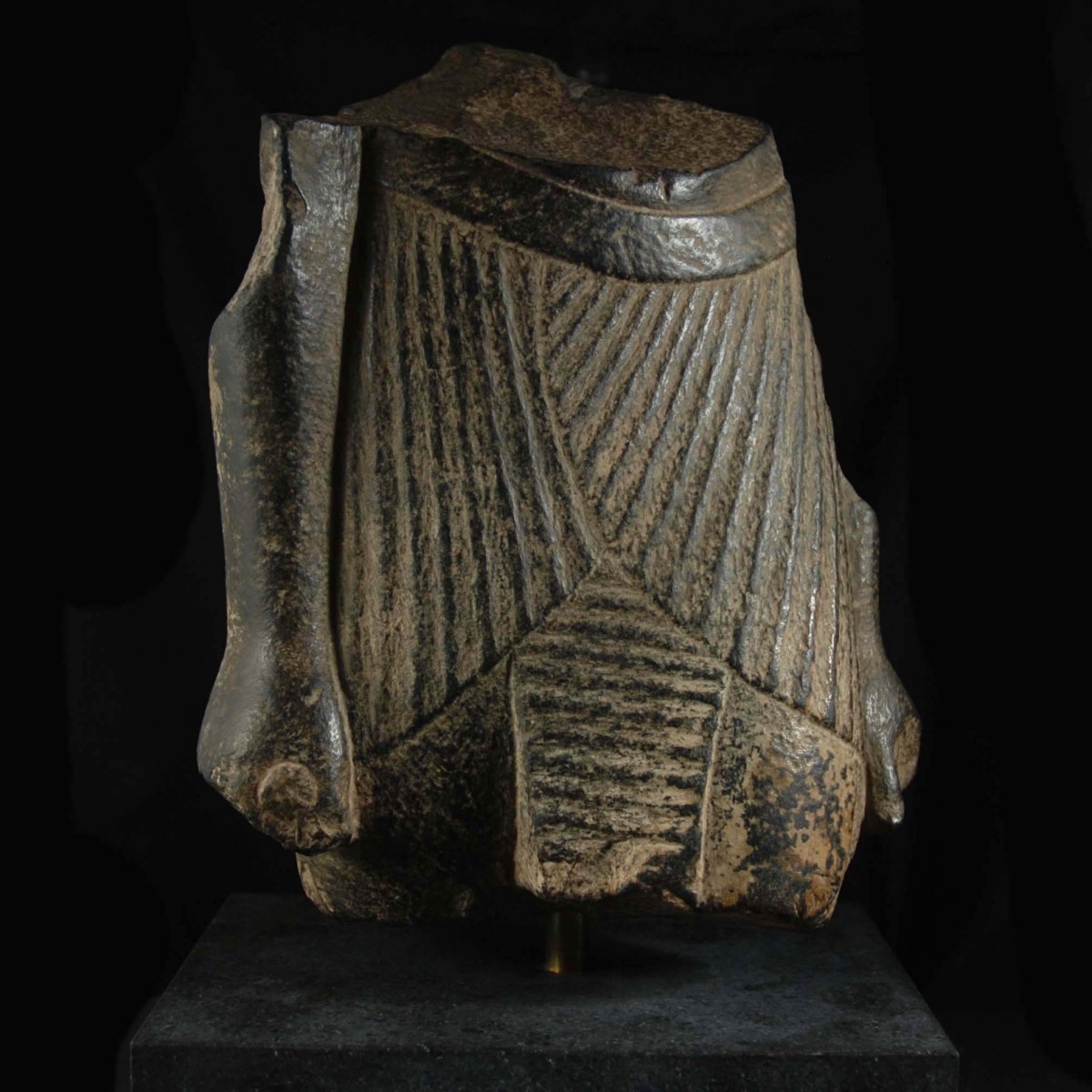
|
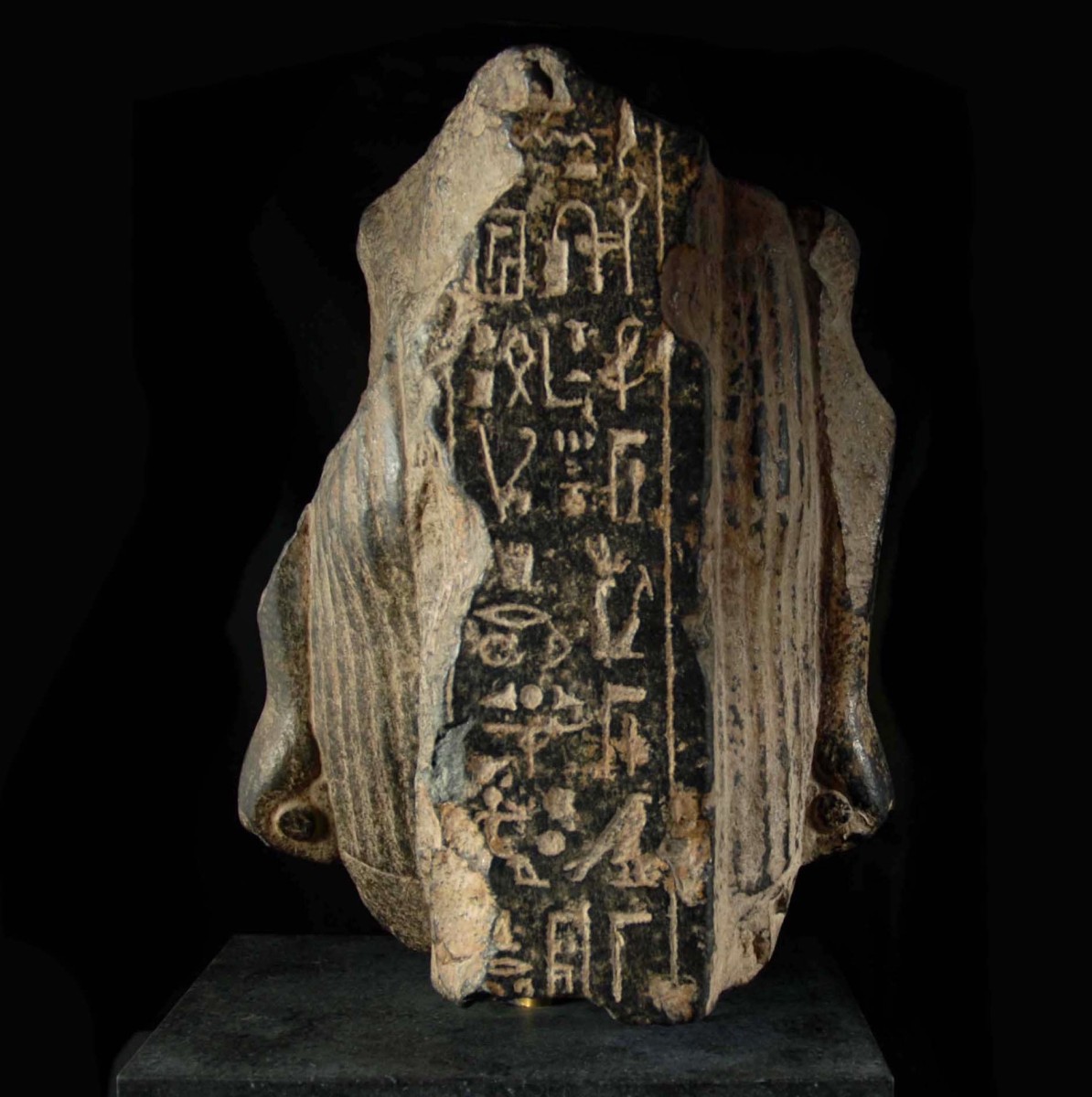
|
|
|
|
Egypt – Late period, 664-332 B.C.
|
Important basalt torso of a striding man, which was already published in 1969. His arms are placed on the body, and his fists hold the emblematic staves. The left leg bent forward in a striding position. He wears a pleated, finely ribbed, tripartite apron with a middle ribbon. On the back pillar and on one side a finely drawn, deeply engraved inscription mentioning the owner of the statue "as the scribe of the first working group of the temple of Nekhbet, the third prophet of Montu, lord of Tod, and prophet of Min and of Harpocrates in the temple of Tod". The text refers to the temple in el-Tod, dedicated to the falcon-headed god of war Montu, 20 kilometre south west of Luxor. This large and important fragment was described already in 1969 by the Egyptologist Jacques Jean Clère (1906-1989) and included in his archives. The archive is kept today in the Griffith Institute of the University of Oxford. Mounted.
|
Provenance: Gallery Le Corneur-Roudillon, Paris 1969. There described by the French Egyptologist Jacques Jean Clère (1906-1989). Thence in a Japanese private collection since 1974. Later with Sotheby’s New York on 5 December 2007, lot 22. Last in a Belgium private collection.
Dimensions: 25 cm high
Price: 68 000 Euro
|
|
|
|
Selected Artworks of the Month:
|
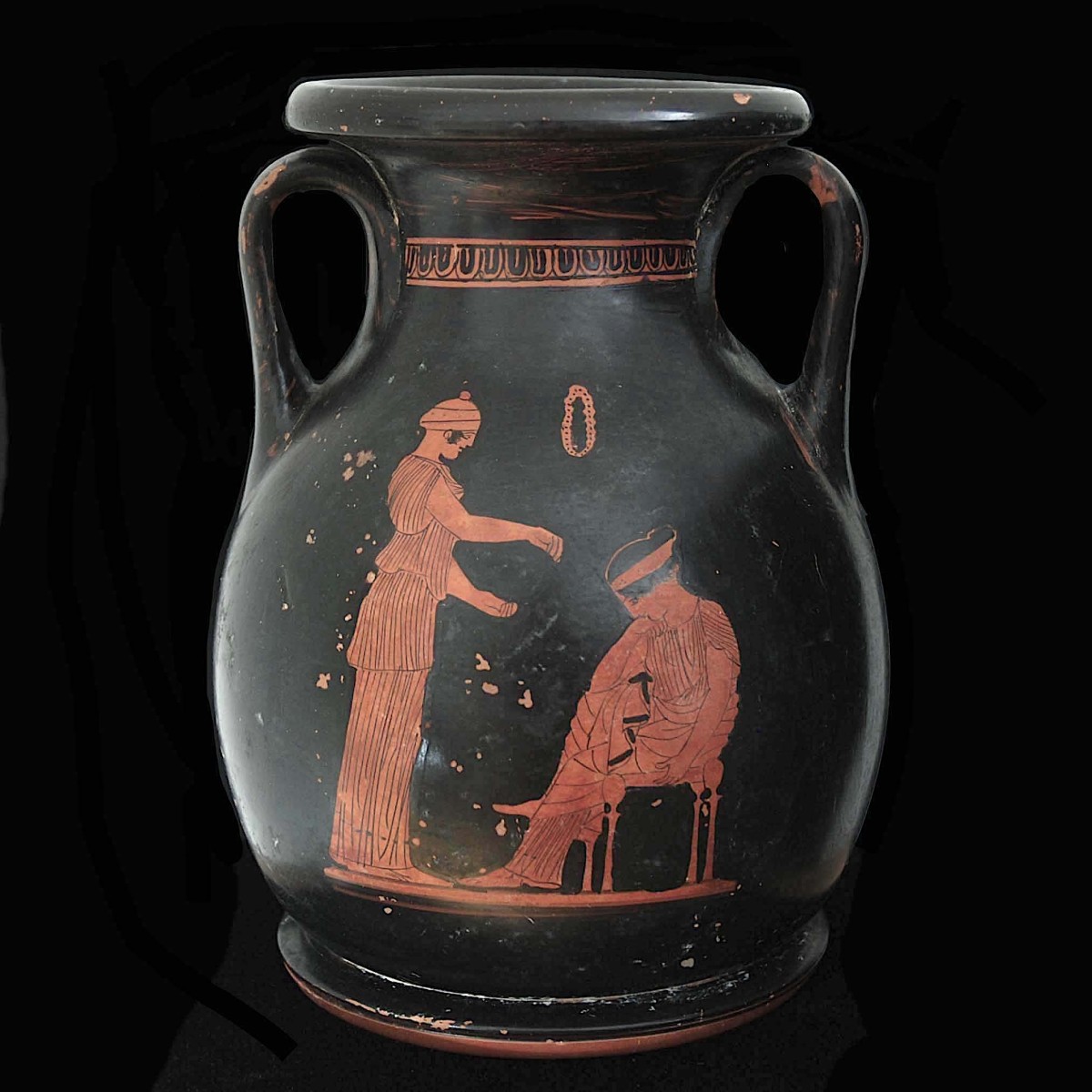
|
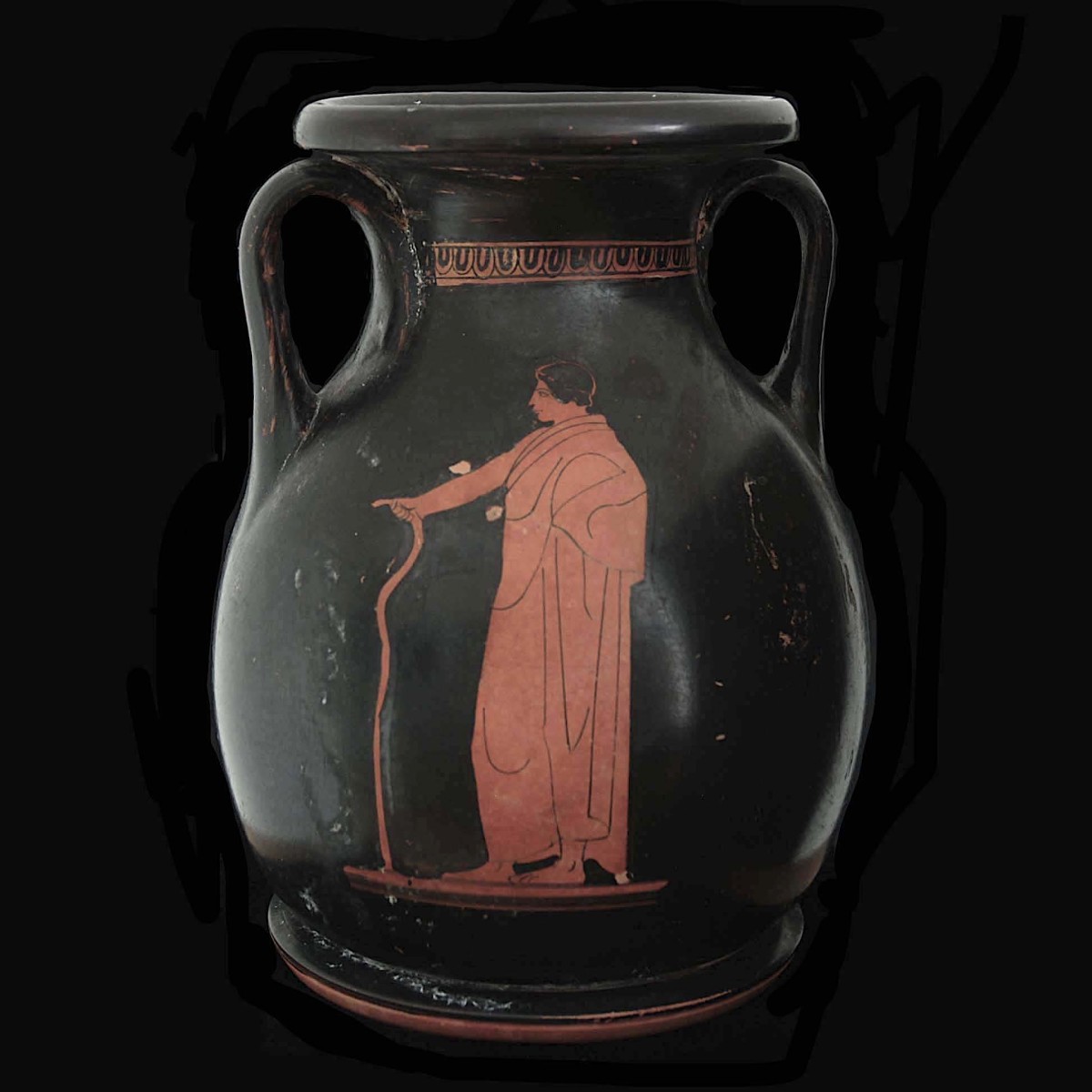
|
Masterly worked out pelike in the red-figured style. The front depicts a woman with a servant. The lady sits on a stool, she wears a chiton and a himation with a black hem. She has her hair pulled back with a broad filet. The right leg is crossed over her left one, and she rests her lowered head on the right arm. She seems to be lost in her thoughts. The depiction corresponds to that of Penelope’s, wife of Odysseus, from the 5th century B.C. Similar representations show a marble sculpture from Persepolis and the Attic Skyphos from Chiusi, which gave the Penelope Painter its name. The servant faces her mistress. She wears a long, pleated chiton and a sakkos over her hair. Her arms are stretched out and handing a filet to the lady. A wreath floating above the scene. The back depicts a young man with a filet and a staff. On the neck between the handles egg-dart motive. Published in: J. Oleson und D. Buitron “Coins and Vases of Arthur Stone Dewing”, Cambridge 1971, number 22. The painting style referring to the Sabouroff painter or one of his successors – the Munich painter 2363 or the Trophy painter.
|
Provenance: American private collection Arthur Stone Dewing (1880-1971), Boston, USA. By decent to his daughter Mary Morain (died 1999) and his son-in-law Lloyd (died 2010). Auctioned with Christie’s New York on 9 June 2011, lot 91. Exhibited in the Boston Museum of Fine Arts from 1961 to 2002. As zzz also in the Fogg Museum Cambridge from 11 March to 15 April 1971, as well as in 2002.
Dimensions: 15.7 cm high
Price: 34 000 Euro
|
|
|
|
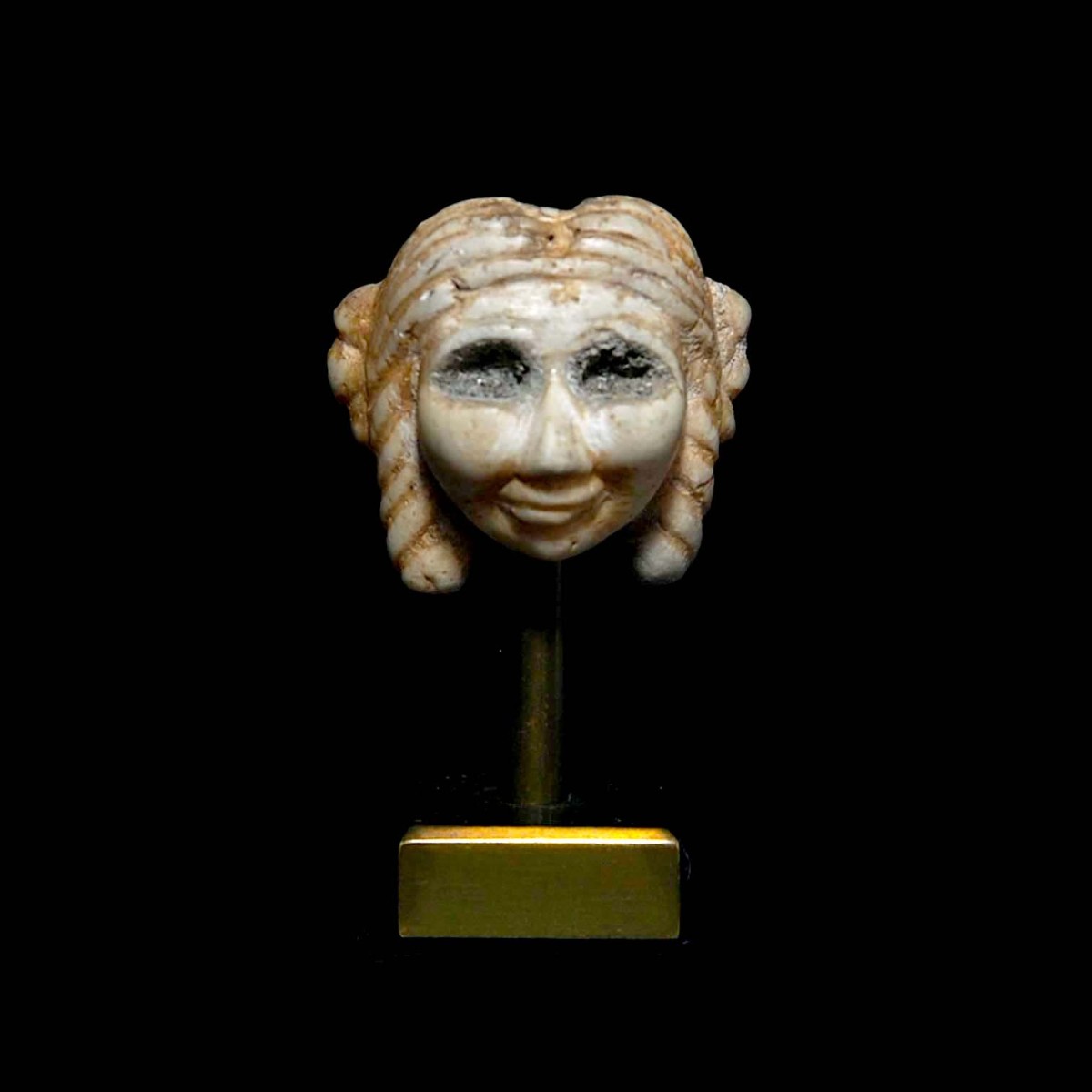
|
|
|
|
|
Marble head amulet of a goddess worked out in high quality. The round head with pronounced cheekbones, a large, prominent nose and a mouth shaped into a smile. The large eyes are pierced deeply into the stone and once held lapis lazuli inlays. The goddess has her hair parted in the middle, sideways long curls cascade over her temples. Behind them protruding bull ears which are typical for Sumerian head amulets. The head is vertically pierced for suspension. Sumerian head amulets are mainly known for male depictions and should personify heroes from the Gilgamesh epic such as Enkidu. Female portrayals like the present one are extremely rare. Possibly this amulet is a representation of Ningal, the goddess of reeds, wife of the moon god Nanna. See the marble head of Ningal from Ur, today in the Penn Museum in Philadelphia, USA, with the object number B16228. Mounted.
|
Provenance: The Bactria Corp., New York, 1960 to 1970s. Thence Merrin Gallery, New York. Last in a New York private collection.
Dimensions: 2.4 cm high
Price: 8 000 Euro
|
|
|
|
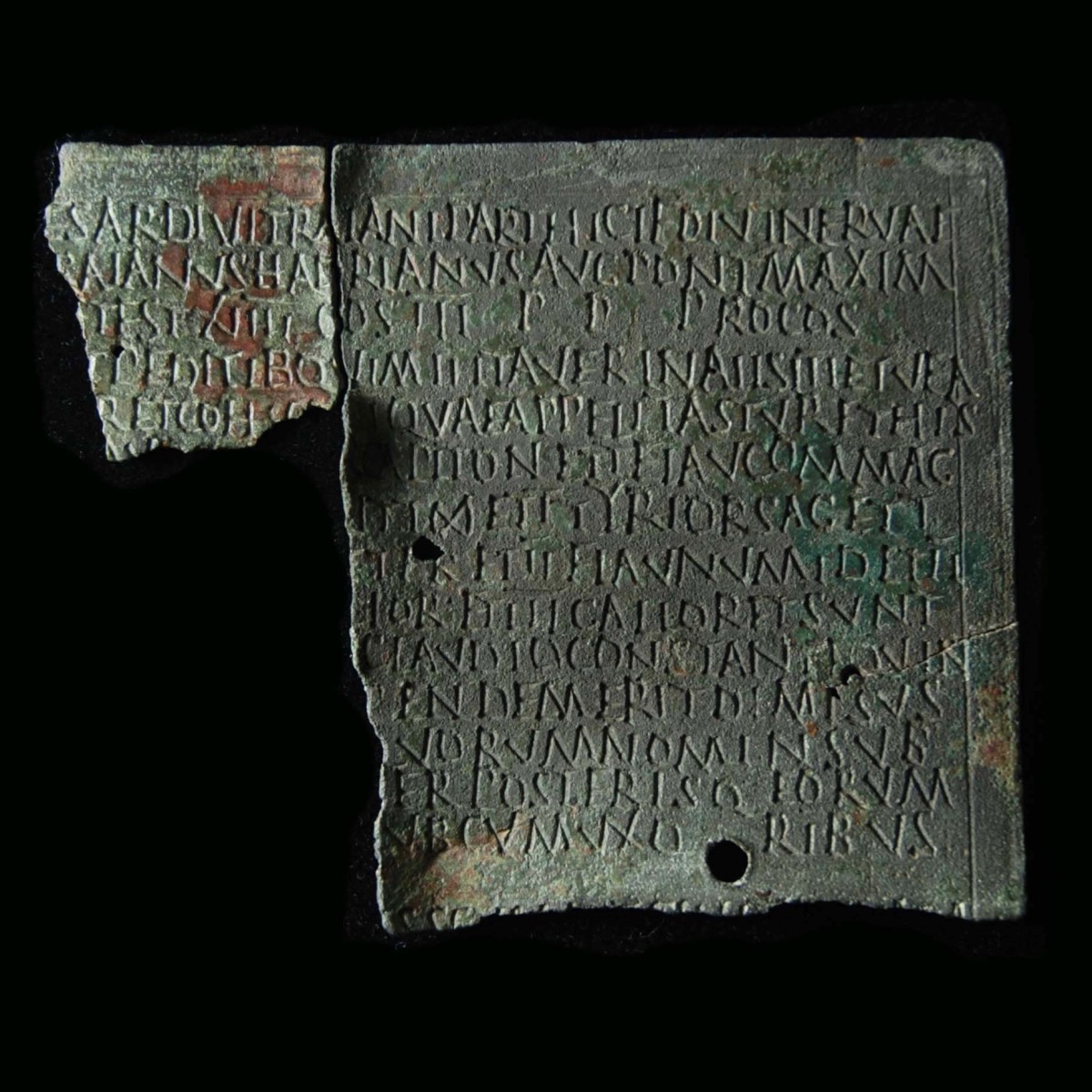
|
|
|

|
|
Roman Empire – 10 December 129 to 9 December 130 A.D.
|
Two belonging fragments of a military diploma from the period of emperor Hadrian. Preserved are large pieces of Tabella I. of a constitution for the province Dacia Inferior from the period between 10 December 129 and 9 December 130 A.D. The diploma has a special meaning due to the listing of troops in the relatively new province which was established by Hadrian in the course of the division of Dacia. Mentioned are in addition to three alae the auxiliary unit “vexillatio equitum Illyricorum” and five cohorts. It may be about veterans from Trajan’s Dacian Wars, who were stationed after the combats in the newly established province. Furthermore, historically important is that for the first time a governor named Claudius Constans is mentioned. See for the importance the publication by Peter Weiß “Neue Militärdiplome”, in: Zeitschrift für Papyrologie und Epigraphik 117, 1997, pages 243-246. Also published in: P. Holder “Roman Military Diplomas V (2006)”, p. 778 f., no. 376.
|
Provenance: From the German collection Peter Weiß, between 1967 and 2015.
Dimensions: 8.1 cm x 10 cm
Price: 6 400 Euro
|
|
|
|
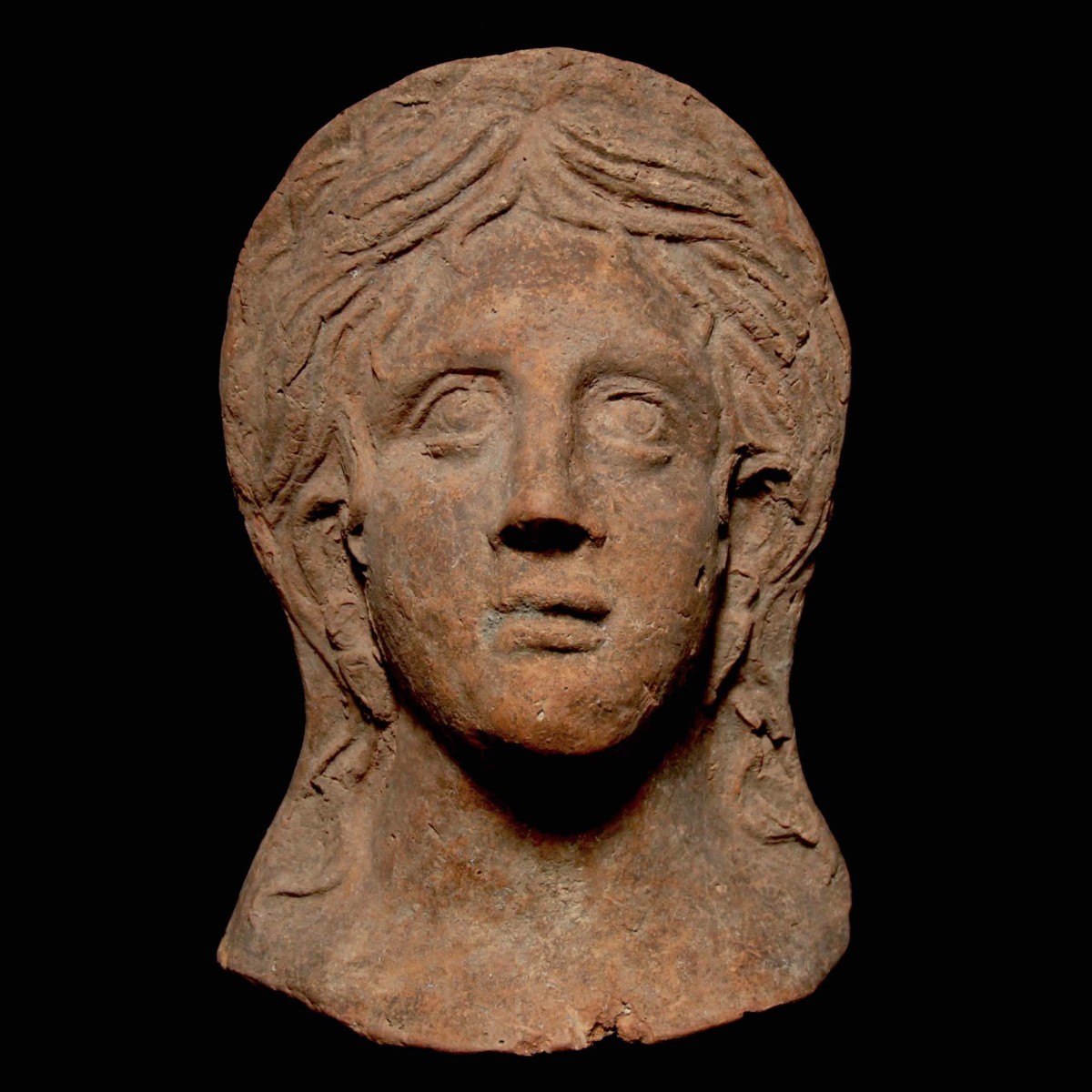
|
|
|
|
|
|
Etruria – 3rd century B.C.
|
Large, moulded Etruscan votive head of a woman. The sculptural face with numerous fine details. The large eyes with drawn iris and punched pupils. The nose prominent and straight. The mouth with thick lips is softly open. Its slightly tilted position gives the face a particularly lively appearance. The woman wears long, tapering earrings. Very noticeable is – compared to other votive heads from this period – the quite messy, long hair. Parted in the middle, it cascades on the sides behind the ears along the head. Left and right one long strand, which reaches to the shoulder. The veil is pulled over her hair (“Capite Velato”). On the back a venting hole.
|
Provenance: European private collection prior to 1970. Last on the Austrian art market.
Dimensions: 29.8 cm high
Price: 4 000 Euro
|
|
|
|
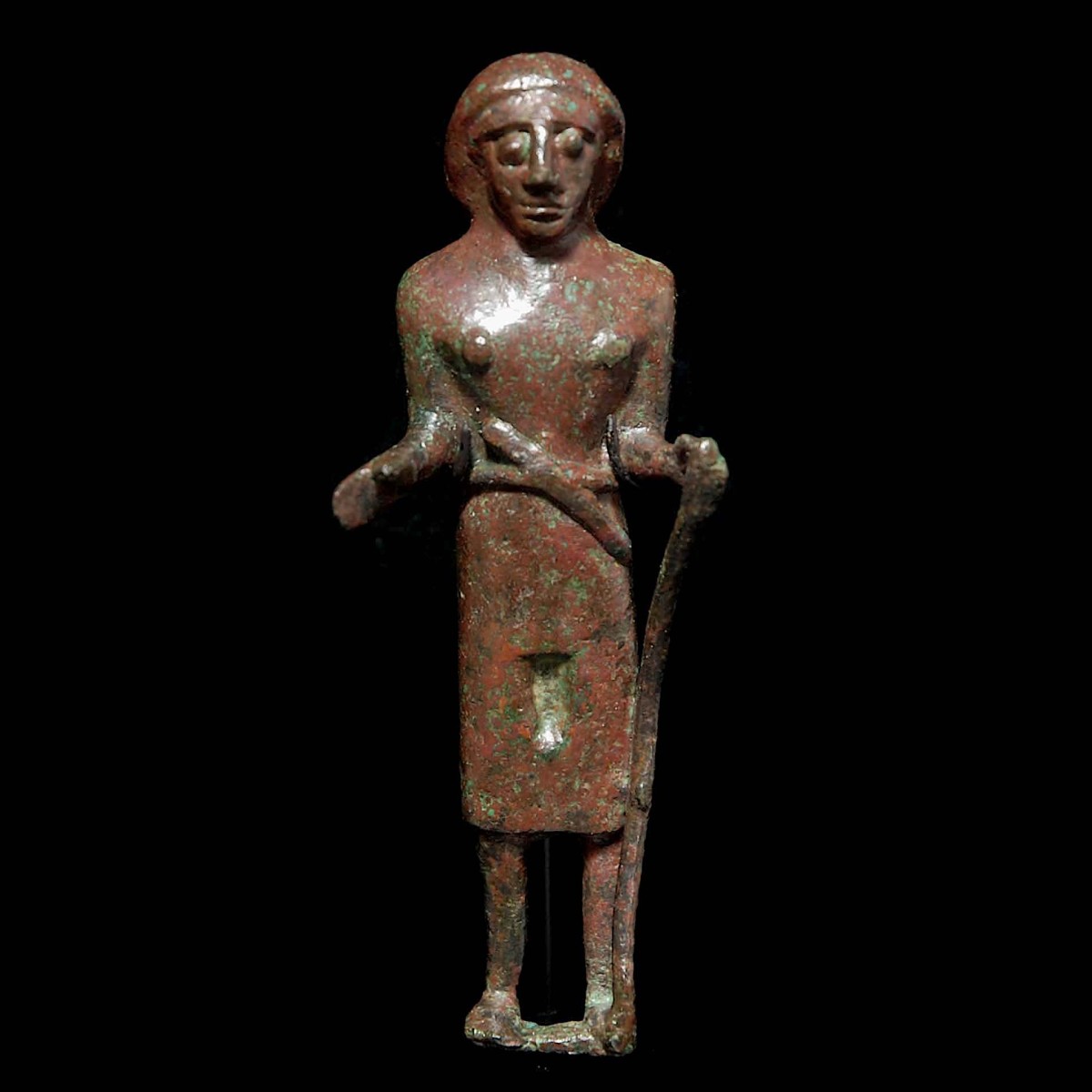
|
|
|
|
|
|
South Arabia/Kingdom of Saba – 1st century B.C.
|
Finely worked out bronze statuette of a female warrior. The figure stands on a small bronze bar which possibly was once attached to a base with an inscription. The figure stands in the gesture of orant. The woman wears a knee-length apron, her upper body is undressed. She holds in her left hand an arc which is placed on the base. The right arm is bent forward, the hand open in a praying gesture. The female warrior has around her belly a belt with a dagger. Very finely worked out statuette, possibly from Wadi Markha. See for these bronze orants "Jemen – Kunst und Archäologie im Land der Königin von Saba", Wilfried Seipel (Hrsg.), Nr. 152, page 291. Mounted.
|
Provenance: Private collection Shlomo Moussaieff (1925-2015), Israel. Acquired between 1948 and 2000.
Dimensions: 9.1 cm high
Price: 2 800 Euro
|
|
|
|
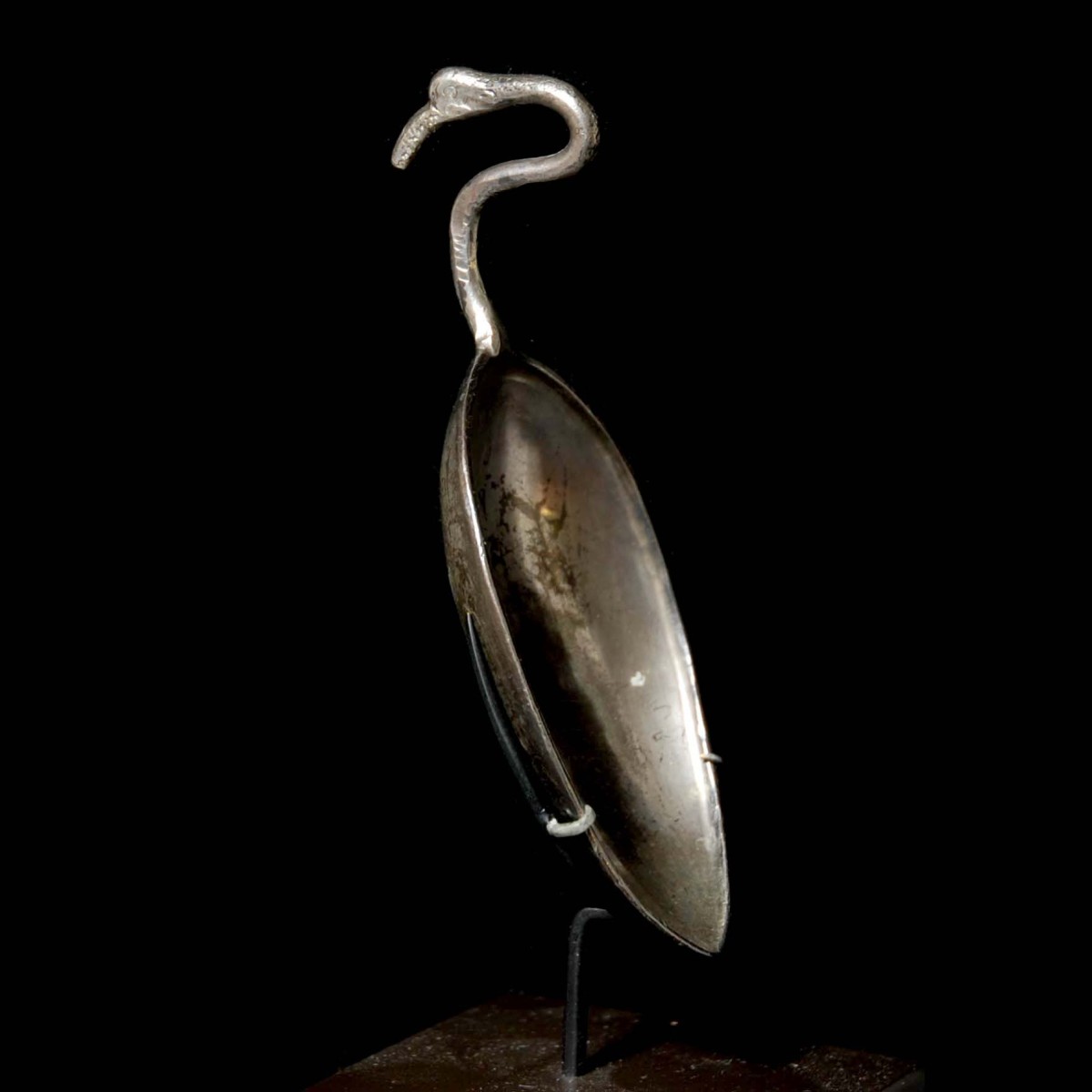
|
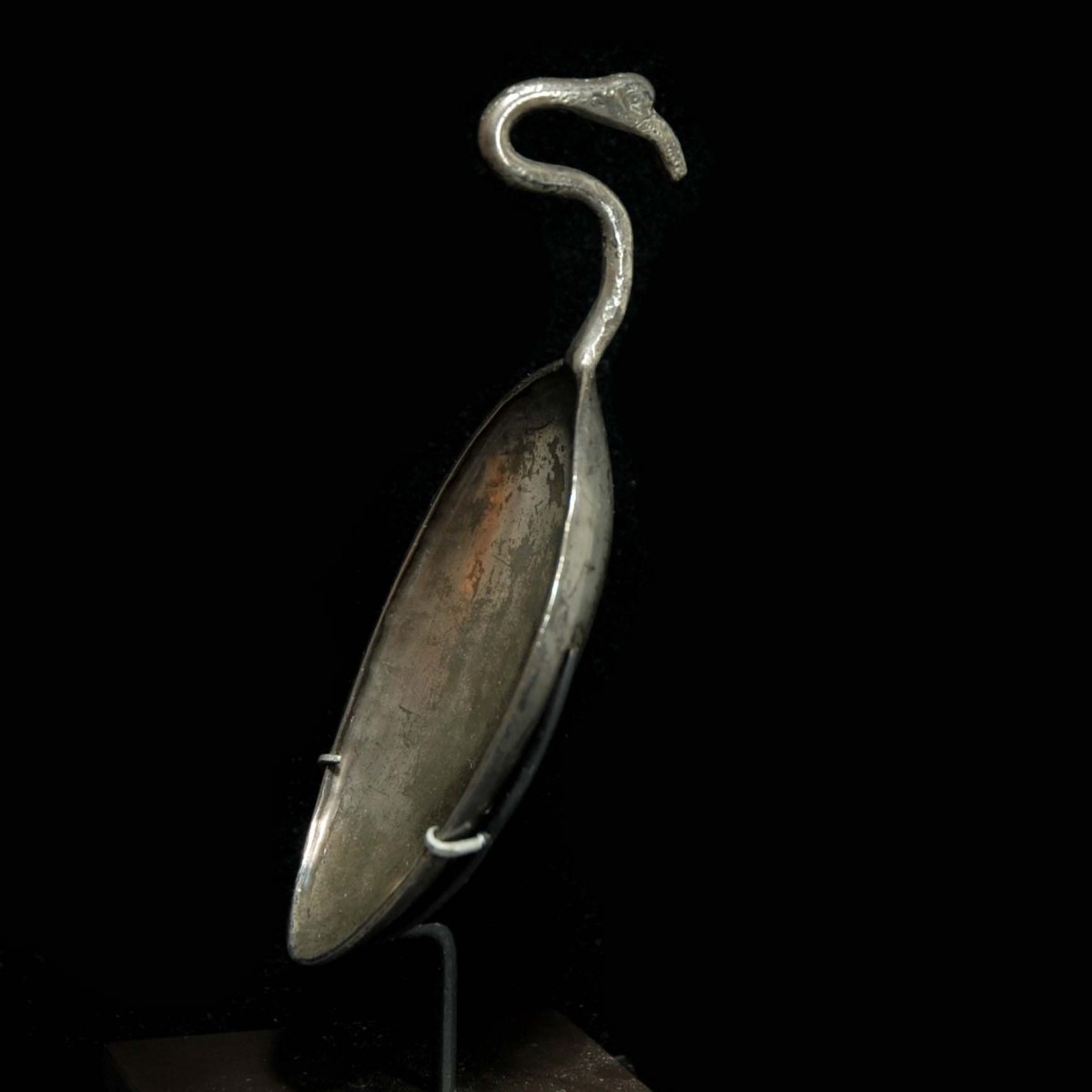
|
|
Roman Empire – 3rd-4th century A.D.
|
Elegant, large silver spoon with a slightly set off rim. The short handle shaped as a S-curve and ending in the finely worked out swan head. Details such as eyes and plumage engraved in cold work. See for the type the spoons with swan and duck heads from the silver hoard in the Canterbury Roman Museum, buried about AD 410. Mounted.
|
Provenance: New York private collection, acquired from the Edward H. Merrin gallery in New York in the 1970s.
Dimensions: 12.1 cm long
Price: 2 800 Euro
|
|
|
|
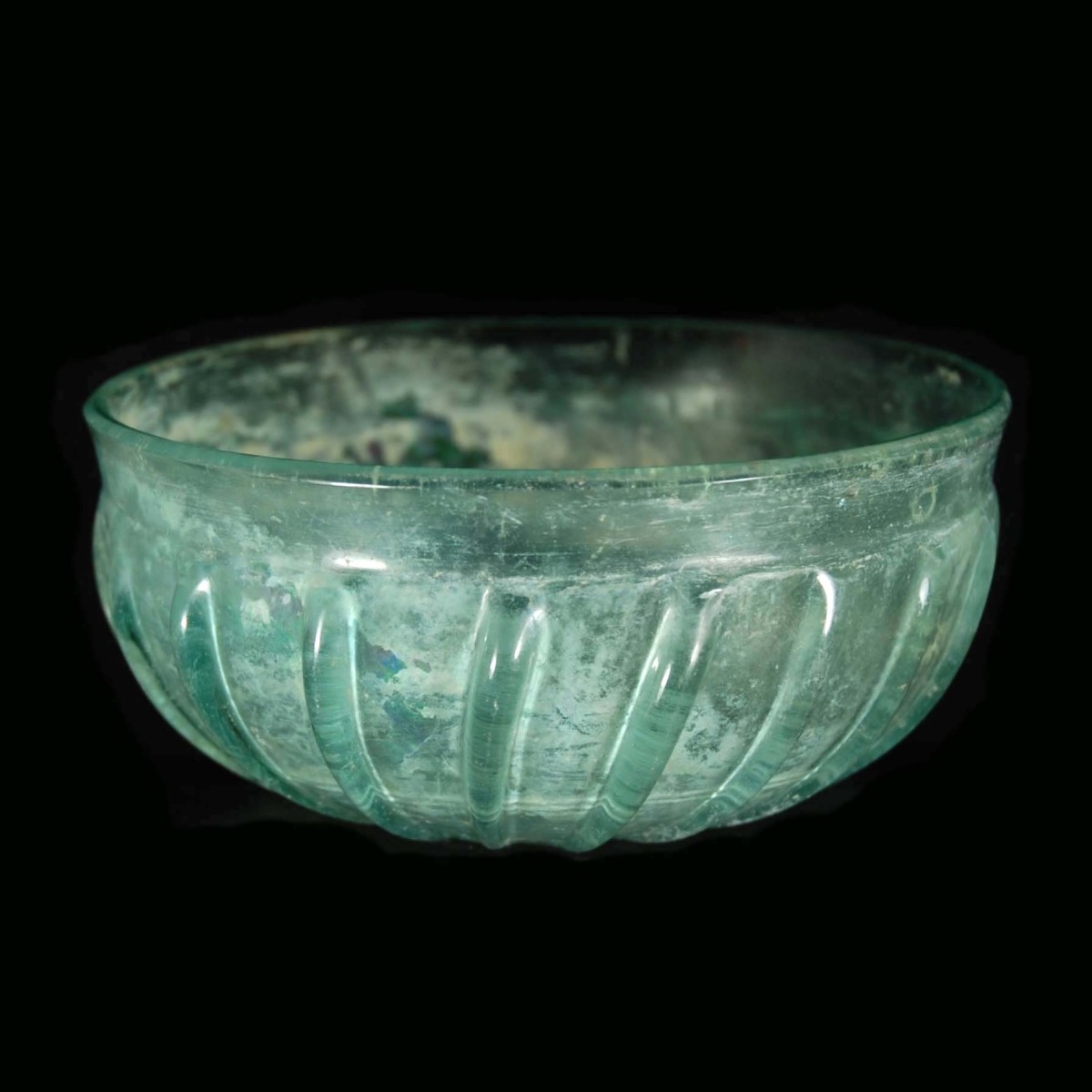
|
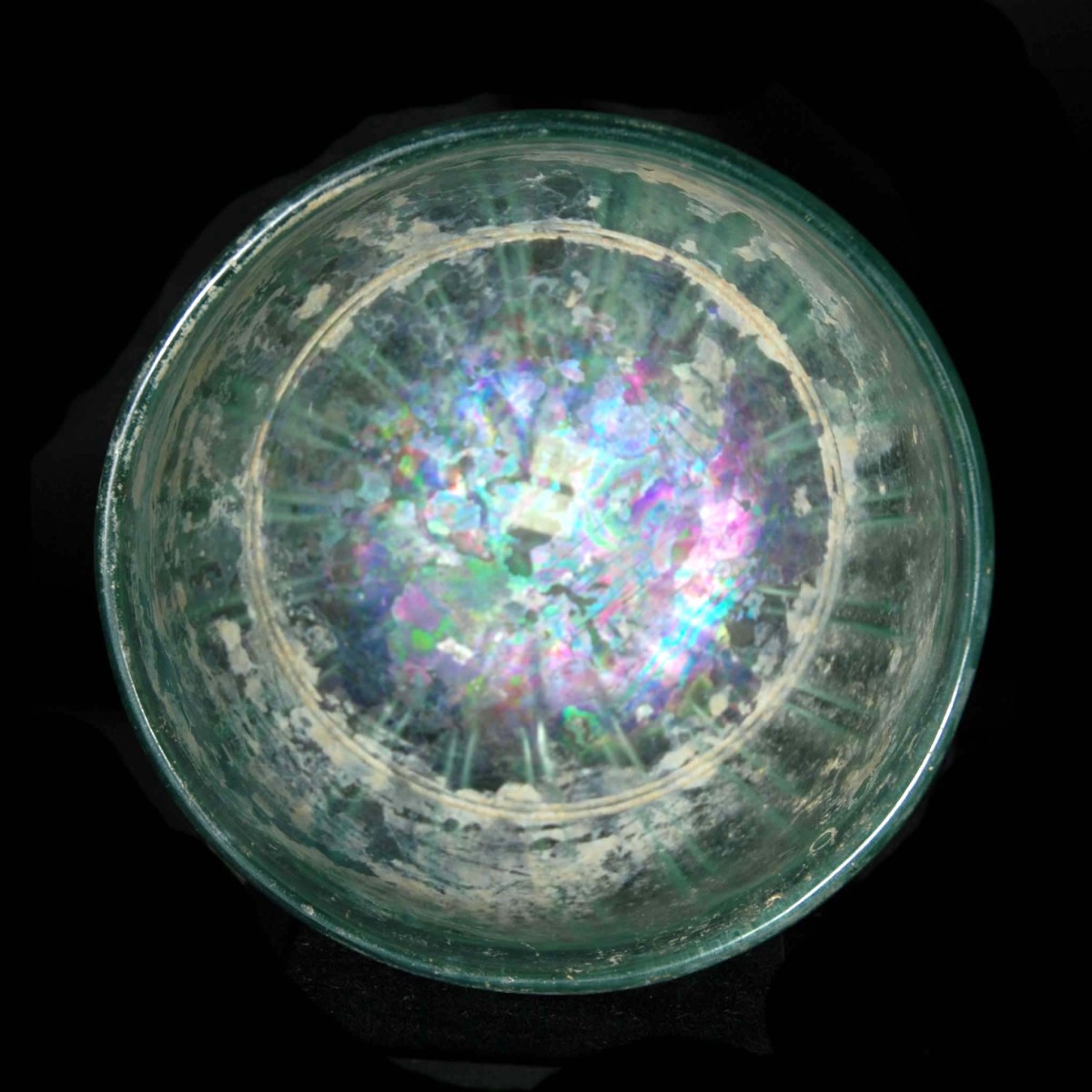
|
|
Roman Empire – 1st century B.C. to 1st century A.D.
|
Beautifully preserved ribbed bowl of greenish clear glass with a magnificent iridescene inside. The steep-walled bowl with a slighthly thickened rim and 19 even ribs. Bowls such as the present one were very popular between 100 B.C. to 130 A.D. During production, the glass mass was potted around a curved core and pressed into ribs from above with wood. Finally, the ribs on the edge of the bowl were pulled with pliers. It is discussed again and again whether ribbed bowls were also used for drinking, in any case they were probably used to wash fingers during the meal. Two old collection labels with the numbers 135 and 267 on the bottom.
|
Provenance: From the private collection of the French archaeologist Louis-Gabriel Bellon (1819-1899). For over 120 years in the family estate.
Dimensions: 11.3 cm diameter
Price: 4 000 Euro
|
|
|
|
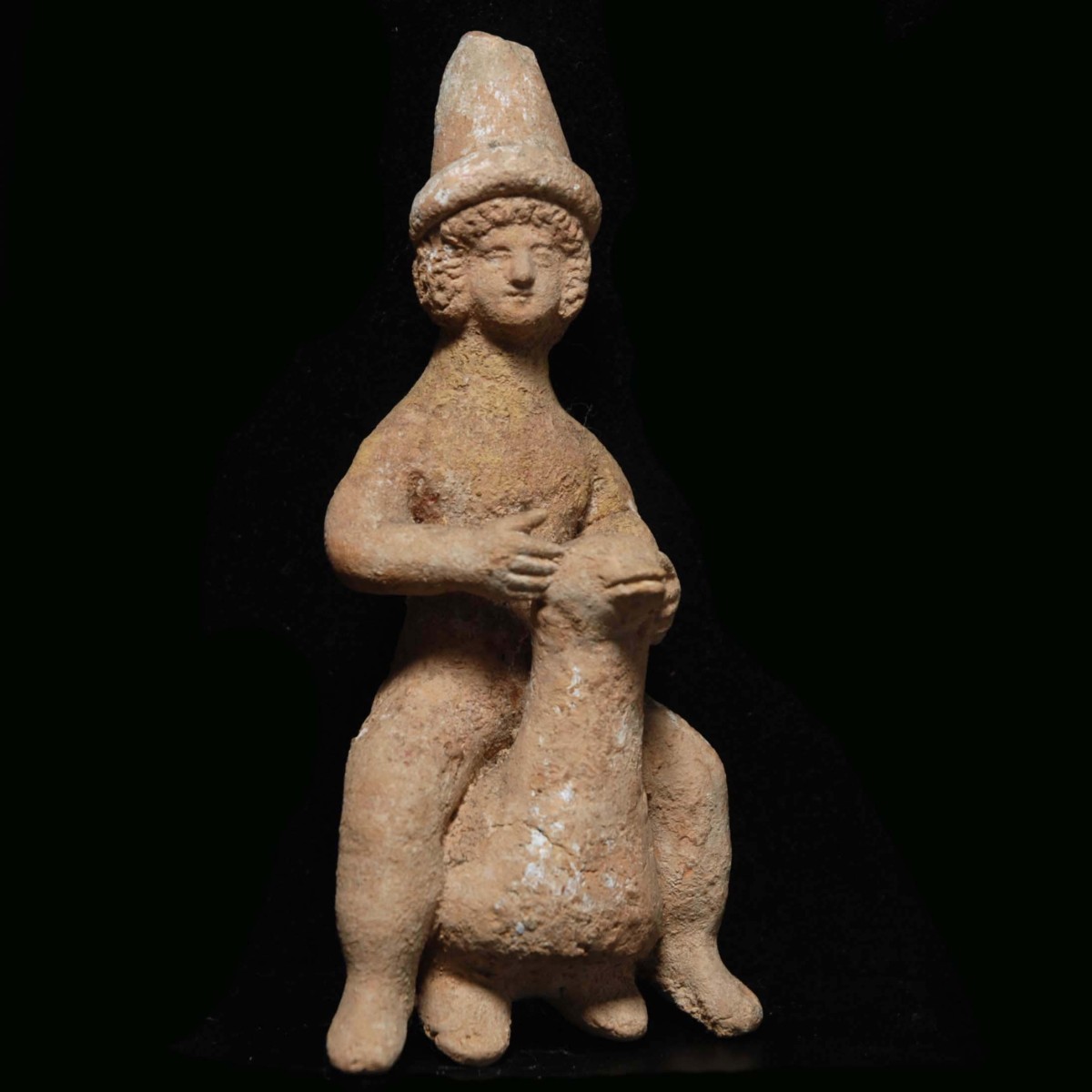
|
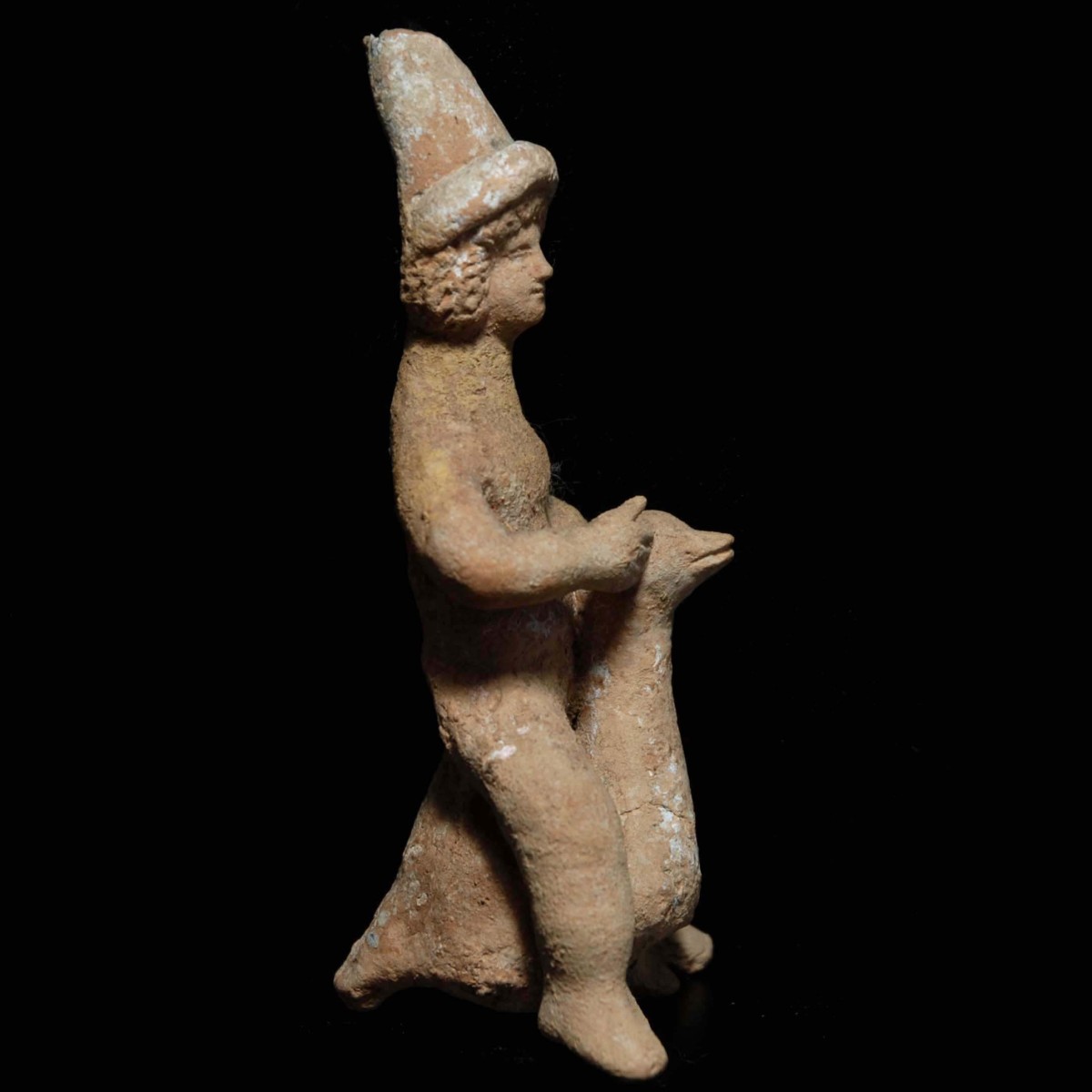
|
|
Greece – 3rd century B.C.
|
Intentive terracotta statuette of a boy riding a goose with his legs apart. The boy wears a noticeably high hat with a broad brim. He holds the water bird with both arms on its head. His curly hair cascades on his forehead and halfway along his temples. See for the depiction the similar statuette in the archaeological museum in Chalcis. On the back an old collection label with the inscription 223.
|
Provenance: From the private collection of the French archaeologist Louis-Gabriel Bellon (1819-1899). For over 120 years in the family estate.
Dimensions: 12.5 cm high
Price: 1 800 Euro
|
|
|
|
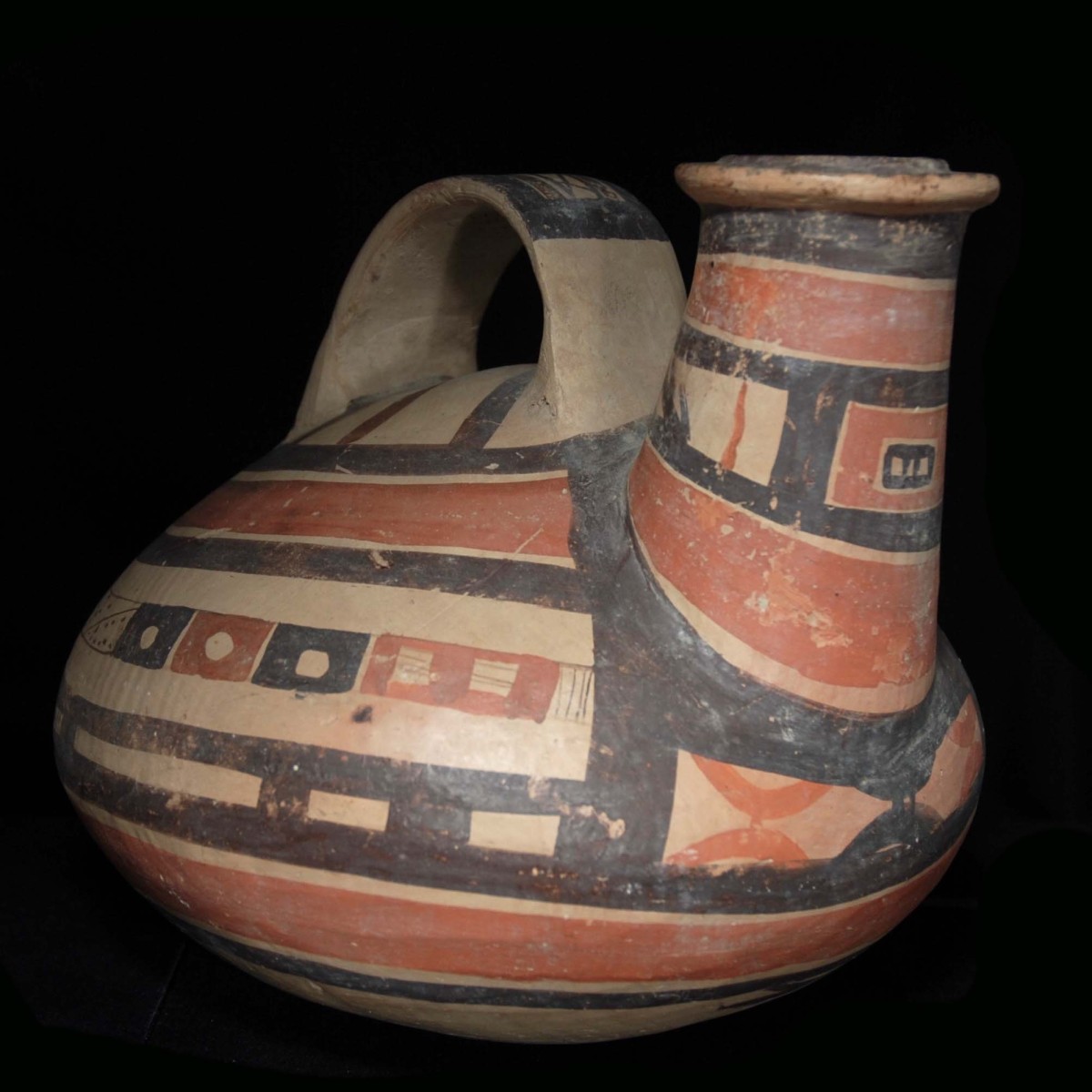
|
|
|
|
|
|
Daunia/Apulia – 5th century B.C.
|
Large Daunian askos with vibrantly preserved colors. The voluminous corpus with a flat base and a semi-circular band handle at the back. The spout is highly raised and with a horizontal, slightly downwards curved rim. The entire vessel is painted in red, brown and black colors. The decoration has geometric décor with bands, wavy lines, cross pattern and dots. A large, very attractive vessel.
|
Provenance: Swiss private collection S. Since several decades in a family estate.
Dimensions: 19.2 cm high
Price: 2.200 Euro
|
|
|
|
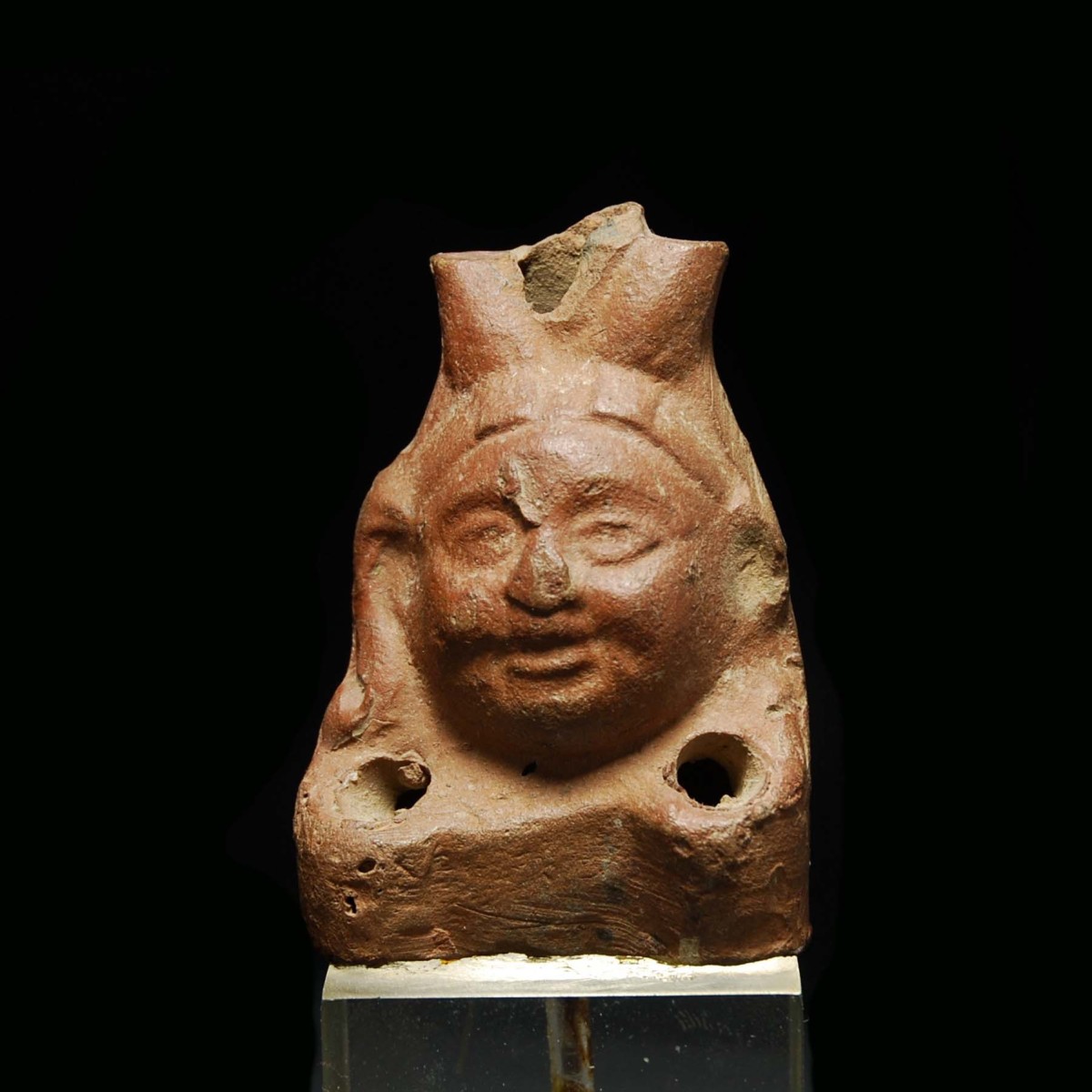
|
|
Egypt – Roman period, 1st century A.D.
|
Egyptian oil lamp fragment from the Roman period depicting Harpocrates. The chubby, youthful face is crowned, the youthful lock cascades on the right side. At the bottom two filling holes, the snout worn on the top. Mounted.
|
Provenance: Collection Wolfgang Zoepnek, Dassendorf, Germany.
Dimensions: 8 cm high
Price: 350 Euro
|
|
|
|
|
|
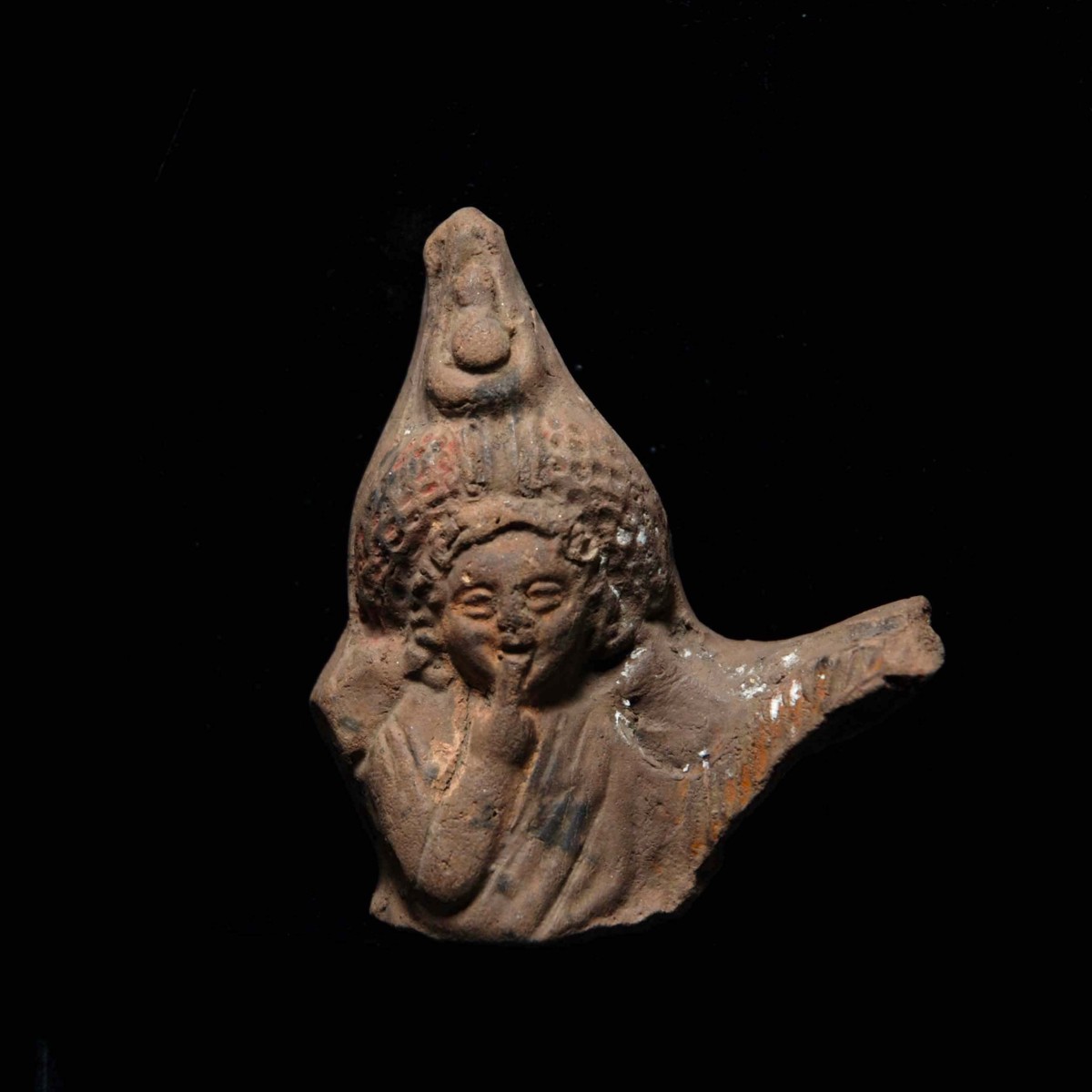
|
|
Egypt – Roman period, 1st-2nd century A.D.
|
Terracotta fragment of a riding Harpokrates. The mane of the horse is still recognisable on the right side. The god depicted as a boy with the index finger of the right hand on his mouth. He wears a lavish hair jewellery and the double crown of Upper- and Lower Egypt. Inside hollow.
|
Provenance: Viennese private collection L. K., acquired from a German auction house.
Dimensions: 8 cm high
Price: 220 Euro
|
|
|
|
|
|
|
|
Das Warten auf Odysseus
|
Über 40 Jahre lang war sie im renommierten Boston Museum of Fine Arts als prominente Leihgabe ausgestellt. Jetzt geht ihre Reise weiter. Die prachtvolle rofigurige Pelike mit der Darstellung einer in Gedanken versunkenen Frau und ihrer Dienerin gehört sicher zu den interessantesten griechischen Vasen, die wir bisher anbieten konnten. Schließlich dürfen wir in der meisterhaft gemalten Frau Penelope erkennen, die melancholisch auf die Rückkehr ihres Mannes Odysseus wartet.
|
Der Torso eines Schreitenden, das Antlitz einer Göttin. Höchste Museumsqualität hat natürlich auch der große ägyptische Basalt Torso eines schreitenden Mannes. 1969 bereits publiziert, stammt das imposante Statuenfragment aus dem Tempel von el-Tod, der dem falkenköpfigen Kriegsgott Month geweiht. Göttlich ist auch das über 4.000 Jahre alte kleine Marmorköpfchen aus Mesopotamien. Und außergewöhnlich obendrein: Schließlich handelt es sich um die äußerst seltene Darstellung einer weiblichen sumerischen Gottheit. Was wir sonst für den Februar vorbereitet haben? Klicken Sie durch!
|
|
|
|
Unser Highlight des Monats:
|
|
Ägypten – Spätzeit, 664-332 v. Chr.
|
Bedeutender und bereits 1969 publizierter Basalt-Torso eines schreitenden Mannes. Er hat die Arme an den Körper angelegt und hält in seinen Fäusten die symbolischen Knüppel. Das linke Bein ist in Schrittstellung nach vorne abgewinkelt. Er trägt einen gefaltenen, fein gerippten, dreiteiligen Schurz mit zentraler Mittelschleife. Am Rückenpfeiler und an einer Seite davon eine fein gezogene, tief gravierte Inschrift, die den Besitzer der Statue „als Schreiber der ersten Arbeitsgemeinschaft des Tempels der Nechbet, als dritten Propheten des Month, Lord von Tod und Prophet der Min und des Harpokrates im Tempel von Tod“ ausweist. Gemeint ist der Tempel von el-Tod, der dem falkenköpfigen Kriegsgott Month geweiht war, 20 Kilometer südwestlich von Luxor. Dieses große und bedeutende Fragment wurde bereits 1969 vom Ägyptologen Jacques Jean Clère (1906-1989) beschrieben und in sein Archiv aufgenommen. Das Archiv wird heute im Griffith Institute an der Universität Oxford verwahrt. Gesockelt.
|
Provenienz: Galerie Le Corneur-Roudillon, Paris 1969. Dort vom französischen Ägyptologen Jacques Jean Clère (1906-1989) beschrieben. Danach japanische Privatsammlung seit 1974. Später Sotheby's New York am 5. Dezember 2007, Los 22. Zuletzt in einer belgischen Privatsammlung.
Höhe: 25 cm
Price: 68.000 Euro
|
|
|
|
Ausgewählte Kunstwerke des Monats:
|
|
Griechenland – um 450 v. Chr.
|
Meisterlich gearbeitete Pelike im rotfigurigen Stil. Die Vorderseite zeigt eine Frau mit ihrer Dienerin. Die Herrin sitzt auf einem Hocker, sie trägt einen Chiton und ein Himation mit schwarzem Rand. Sie hat das Haar mit einem breiten Band nach hinten gebunden. Das rechte Bein ist über ihr linkes geschlagen und sie hat ihren gesenkten Kopf am rechten Arm abgestützt. Sie scheint in Gedanken versunken. Diese Darstellung entspricht jener der Penelope, der Ehefrau des Odysseus, aus dem 5. Jahrhundert v. Chr. Ähnliche Darstellungen zeigen eine Marmorskulptur aus Persepolis und der attische Skyphos aus Chiusi, der dem Penelope-Maler seinen Namen gab. Die Dienerin steht ihrer Herrin gegenüber. Sie trägt einen langen, faltenreichen Chiton und einen Sakkos über den Haaren. Ihre Arme sind nach vorne gestreckt und reichen der Herrin ein Haarband. Ein Kranz schwebt über der Szene. Die Rückseite zeigt einen jungen Mann mit Haarband und Gehstock. Am Hals zwischen den Henkeln Eierstabmuster. Publiziert in: J. Oleson und D. Buitron „Coins and Vases of Arthur Stone Dewing”, Cambridge 1971, Nummer 22. Der Malstil weist auf den Sabouroff Maler oder einen seiner Nachfolger – den Maler von München 2363 oder den Trophy Maler – hin.
|
Provenienz: Amerikanische Privatsammlung Arthur Stone Dewing (1880-1971), Boston. Durch Erbe an die Tochter Mary Morain (gestorben 1999) und den Schwiegersohn Lloyd (gestorben 2010). Versteigert bei Christies New York am 9. Juni 2011, Los 91. Ausgestellt im Boston Museum of Fine Arts von 1961 bis 2002. Als Leihgabe ebenfalls im Fogg Museum Cambridge von 11. März bis 15. April 1971 sowie im Jahr 2002.
Höhe: 15,7 cm
Preis: 34.000 Euro
|
|
|
|
|
Sumer – 2300-2100 v. Chr.
|
Hochwertig gearbeitetes Kopf-Amulett einer Göttin aus Marmor. Der runde Kopf mit ausgeprägten Backenknochen, großer, prägnanter Nase und einem zu einem Lächeln geformten Mund. Die großen Augen sind tief in den Stein gebohrt und enthielten einst Einlagen aus Lapislazuli. Die Göttin hat ihr Haar in der Mitte gescheitelt, seitlich fallen ihr lange Locken über die Schläfen hinab. Dahinter stehen die für sumerische Kopf-Amulette typischen Stierohren seitlich ab. Der Kopf ist vertikal zur Aufhängung durchbohrt. Sumerische Kopfamulette sind vor allem von männlichen Darstellungen bekannt und sollen Helden des Gilgamesch-Epos wie Enkudi verkörpern. Weibliche Darstellungen wie diese sind ausgesprochen selten. Womöglich handelt es sich bei diesem Amulett um eine Darstellung der Eidgöttin Göttin Ningal, der Gattin des Mondgottes Nanna. Vergleiche dazu den Marmorkopf der Ningal aus Ur, heute im Penn Museum in Philadelphia, USA, mit der Objektnummer B16228. Gesockelt.
|
Provenienz: The Bactria Corp., New York, 1960 bis 1970er Jahre. Danach Merrin Gallery, New York. Zuletzt in einer New Yorker Privatsammlung.
Höhe: 2,4 cm
Preis: 8.000 Euro
|
|
|
|
|
Römisches Reich – 10. Dezember 129 bis 9. Dezember 130 n. Chr.
|
Zwei zusammengehörige Fragmente eines Militärdiploms aus der Zeit des Kaisers Hadrian. Erhalten sind große Teile der Tabella I. von einer Konstitution für die Provinz Dacia inferior aus der Zeit zwischen dem 10 Dezember 129 und dem 9. Dezember 130 n. Chr. Das Diplom hat besondere Bedeutung aufgrund der Aufzählung der Truppenliste in der relativ jungen von Hadrian im Zuge der Teilung Dakiens eingerichteten Provinz. Genannt werden neben drei Alae die Auxiliareinheit „vexillatio equitum Illyricorum“ und fünf Kohorten. Es dürfte sich dabei um Veteranen aus den Dakerkriegen des Trajan handeln, die nach den Kampfhandlungen in der neu errichteten Provinz stationiert blieben. Historisch bedeutend ist darüber hinaus, dass in diesem Diplom erstmals ein Statthalter namens Claudius Constans erwähnt wird. Siehe zur Bedeutung die Publikation Peter Weiß „Neue Militärdiplome“, In: Zeitschrift für Papyrologie und Epigraphik 117, 1997, Seite 243-246. Ebenfalls publiziert in: P. Holder „Roman Military Diplomas V (2006), S. 778 f., Nr. 376.
|
Provenienz: Aus der deutschen Sammlung Peter Weiß, erworben zwischen 1967 und 2015.
Dimensionen: 8,1 cm x 10 cm
Preis: 6.400 Euro
|
|
|
|
|
Etrurien – 3. Jahrhundert v. Chr.
|
Aus der Form gearbeiteter, großer etruskischer Votivkopf einer Frau. Das plastische Gesicht mit zahlreichen feinen Details. Die großen Augen mit gezogener Iris und punzierten Pupillen. Die Nase ausgeprägt und gerade. Der Mund mit dicken Lippen ist leicht geöffnet. Seine leicht schiefe Stellung gibt dem Gesicht eine besonders lebendige Ausstrahlung. Die Frau trägt lange, unten spitz zulaufende Ohrringe. Besonders auffällig ist das – im Vergleich zu anderen Votivköpfen aus dieser Zeit – recht ungeordnete, lange Haar. In der Mitte gescheitelt, fällt es seitlich hinter den Ohren den Kopf hinab. Links und rechts eine lange Strähne, die bis zur Schulter reicht. Über das Haar hat sie einen Schleier gezogen („Capite Velato“). Auf der Rückseite ein Brennloch. Eine winzige Fehlstelle an der links herabfallenden Locke sowie ein antiker kleiner Chip an der Basis. Sonst wunderbar erhalten.
|
Provenienz: Europäische Privatsammlung vor 1970. Zuletzt im österreichischen Kunsthandel.
Höhe: 29,8 cm
Preis: 4.000 Euro
|
|
|
|
|
Südarabien/Königreich Saba – 1. Jahrhundert v. Chr.
|
Fein gearbeitete Bronze-Statuette einer Kriegerin. Die Figur steht auf einem kleinen Bronze-Steg, über den sie wohl einst auf einem mit einer Inschrift versehenen Sockel verbunden war. Die Figur steht im Oranten-Gestus. Die Frau trägt einen knielangen Schurz, ihr Oberkörper ist unbekleidet. In ihrer linken Hand hält sie das Ende eines Bogens, der am Boden abgestellt ist. Der rechte Arm ist nach vorne abgewinkelt, die Hand zum Gebetsgestus geöffnet. Die Kriegerin hat einen Gürtel um den Bauch gebunden, in dem vorne ein Dolch steckt. Sehr fein gearbeitete Statuette wohl aus Wadi Markha. Vergleiche zu diesen Bronze-Oranten „Jemen – Kunst und Archäologie im Land der Königin von Saba“, Wilfried Seipel (Hrsg.), Nr. 152, Seite 291. Gesockelt.
|
Provenienz: Privatsammlung Shlomo Moussaieff (1925-2015), Israel. Erworben zwischen 1948 und 2000.
Höhe: 9,1 cm
Preis: 2.800 Euro
|
|
|
|
|
Römisches Reich – 3.-4. Jahrhundert n. Chr.
|
Eleganter, großer Silberlöffel mit leicht abgesetztem Rand. Der kurze Henkel schwingt S-förmig ab und endet in einem fein gearbeiteten Schwanenkopf. Details wie Augen und Gefieder in Kaltarbeit eingraviert. Vergleiche zum Typus die Löffel mit Schwanen- und Entenköpfen aus dem Silber-Hortfund im Canterbury Roman Museum, der um 410 n. Chr. vergraben wurde. Gesockelt.
|
Provenienz: New Yorker Privatsammlung, erworben in der Edward H. Merrin Gallery in New York in den 1970er Jahren.
Länge: 12,1 cm
Preis: 2.800 Euro
|
|
|
|
|
Römisches Reich – 1. Jahrhundert v. Chr. bis 1. Jahrhundert n. Chr.
|
Wunderbar erhaltene Rippenschale aus grünlichem Klarglas mit prachtvoller Irisierung im Inneren. Die steilwandige Schale mit leicht verdicktem Rand und 19 regelmäßigen Rippen. Schalen wie diese waren zwischen 100 vor und 130 n. Christus sehr beliebt. Bei der Herstellung wurde die Glasmasse um einen gewölbten Kern getöpfert und von oben her mit Hölzern zu Rippen gedrückt. Zuletzt wurden die Rippen am Schalenrand mit Zangen gezogen. Immer wieder wird diskutiert, ob Rippenschalen auch zum Trinken verwendet wurden, jedenfalls dienten sie wohl zur Fingerwaschung während dem Mahl. An der Unterseite zwei alte Sammlungsetiketten mit den Nummern 135 und 267.
|
Provenienz: Aus der Privatsammlung des französischen Archäologen Louis-Gabriel Bellon (1819-1899). Seit über 120 Jahren in Familienbesitz.
Durchmesser: 11,3 cm
Preis: 4.000 Euro
|
|
|
|
|
Griechenland – 3. Jahrhundert v. Chr.
|
Originelle Terrakotta-Statuette eines Knaben, der breitbeinig auf einer Gans reitet. Der Knabe trägt einen auffällig hohen Hut mit breiter Krempe. Er hält den Wasservogel mit beiden Armen am Kopf fest. Sein gelocktes Haar fällt ihm in die Stirn und halblang die Schläfen herab. Vergleiche zur Darstellung die wesensgleiche Statuette im archäologischen Museum von Chalkis. Auf der Rückseite ein altes Sammlungsetikett mit der Aufschrift 223.
|
Provenienz: Aus der Privatsammlung des französischen Archäologen Louis-Gabriel Bellon (1819-1899). Seit über 120 Jahren in Familienbesitz.
Höhe: 12,5 cm
Preis: 1.800 Euro
|
|
|
|
|
Daunien – 5. Jahrhundert v. Chr.
|
Großer daunischer Askos mit kräftig erhaltenen Farben. Der voluminöse Korpus mit flacher Basis und halbrundem Bandhenkel am Rücken. Der Ausguss ist hoch aufgerichtet mit horizontalem, leicht nach unten gewölbtem Rand. Das gesamte Gefäß ist mit roter, brauner und schwarzer Farbe bemalt. Die Dekoration zeigt geometrisches Dekor mit Bändern, Wellenlinien, Kreuzmuster und Punkten. Ein großes, sehr attraktives Gefäß.
|
Provenienz: Schweizer Privatsammlung S. Seit mehreren Jahrzehnten in Familienbesitz.
Höhe: 19,2 cm
Preis: 2.200 Euro
|
|
|
|
|
Ägypten – Römische Zeit, 1. Jahrhundert n. Chr.
|
Ägyptisches Öllampen-Fragment aus römischer Zeit, das eine Darstellung des Harpokrates zeigt. Das pausbäckige, jugendliche Gesicht ist bekrönt, die jugendliche Haarlocke fällt rechts herab. Unten zwei Einfülllöcher, Schnauze oben bestoßen. Gesockelt.
|
Provenienz: Sammlung Wolfgang Zoepnek, Dassendorf, Deutschland.
Höhe: 8 cm
Preis: 350 Euro
|
|
|
|
|
Ägypten – Römische Zeit, 1.-2. Jahrhundert n. Chr.
|
Terrakotta-Fragment eines reitenden Harpokrates. Die Mähne des Pferdes ist rechts noch erkennbar. Der Gott als Knabe dargestellt mit dem Zeigefinger der rechten Hand zum Mund gehalten. Er trägt einen üppigen Haarschmuck und die Doppelkrone von Ober- und Unterägypten. Innen hohl.
|
Provenienz: Wiener Privatsammlung L.K., erworben in einem deutschen Auktionshaus.
Höhe: 8 cm
Preis: 220 Euro
|
|
|
|
|
|
|
CHRISTOPH BACHER ARCHÄOLOGIE ANCIENT ART GmbH
|
Galerie: Stubenring 20, A-1010 Wien
Showroom: Untere Viaduktgasse 55, A-1030 Wien
|
|
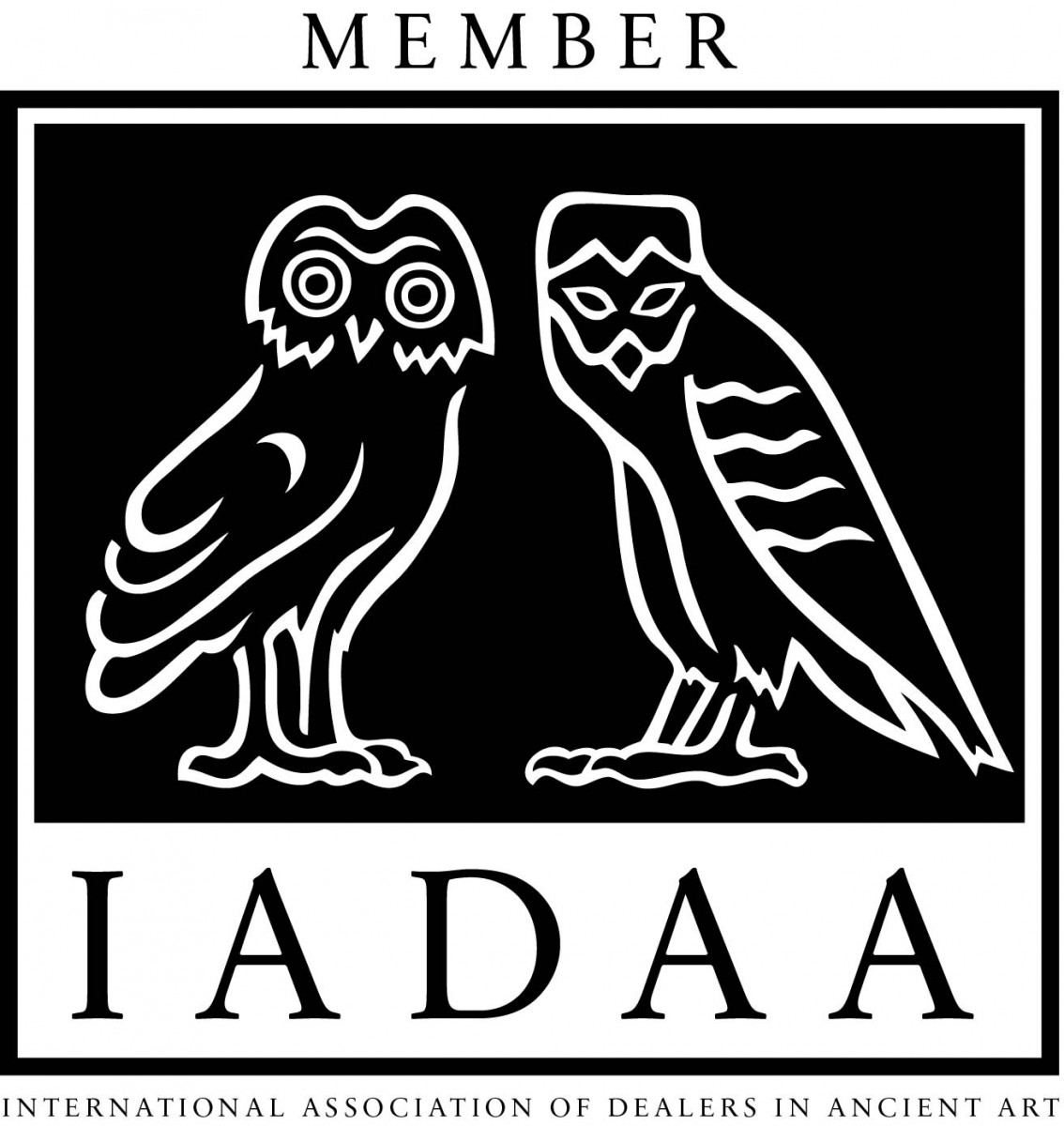
|
|
|
|